Karate
Karate is a Japanese martial art that primarily involves striking techniques using the hands, feet, knees, and elbows. It was developed on the island of Okinawa, which is now part of Japan, in the late 19th and early 20th centuries.
Karate training usually includes three main components: kihon (basic techniques), kata (pre-arranged forms), and kumite (sparring). In kihon, practitioners learn the fundamental techniques and movements, such as punches, kicks, blocks, and stances. Kata involves performing a series of pre-arranged movements against imaginary opponents, which helps to develop timing, balance, and coordination. Kumite is the practice of sparring with an opponent in a controlled environment to develop one’s fighting skills and reflexes.
There are several different styles of karate, including Shotokan, Goju-ryu, Shito-ryu, and Wado-ryu, among others. Each style has its own unique techniques, training methods, and philosophy.
In addition to being a martial art, karate is also considered a form of physical exercise and has been shown to have many health benefits, including improved cardiovascular health, flexibility, and strength. Many people also practice karate for self-defense purposes or as a competitive sport.
Here are some additional pieces of information about karate:

History:
Karate originated in the Ryukyu Kingdom (present-day Okinawa, Japan) in the 17th century as a form of unarmed combat. It was influenced by Chinese martial arts and was primarily used for self-defense. It wasn’t until the early 20th century that karate was introduced to Japan and became more widely known and practiced.
Belt System:
Karate uses a colored belt system to indicate a student’s rank and progress. The belt colors typically range from white (beginner) to black (expert), with several intermediate colors in between. The ranking system and requirements can vary depending on the karate style and school.
Competition:
Karate has become a popular competitive sport, with international organizations such as the World Karate Federation (WKF) organizing tournaments and championships. Karate competitions involve sparring, as well as demonstrations of kata.
Philosophy:
Karate is not just about physical technique but also includes a philosophy and code of conduct. The principles of karate include respect, humility, perseverance, and self-discipline. Many karate practitioners also follow the “Dojo Kun,” which is a set of five precepts that guide behavior both inside and outside the dojo (training hall).
Equipment:
Karate practitioners typically wear a uniform called a gi, which consists of a white jacket and pants with a colored belt. Protective equipment such as gloves, shin guards, and mouthguards may also be used during sparring or competition.
Here are some more interesting facts and details about karate:
Karate Styles:
There are many different styles of karate, each with its own unique characteristics and techniques. Some of the most popular styles include Shotokan, Goju-ryu, Shito-ryu, and Wado-ryu. Each style emphasizes different aspects of karate, such as strength, speed, and agility.
Karate for Self-Defense:
While karate is often practiced for its physical and mental benefits, it is also an effective form of self-defense. Karate techniques focus on striking vulnerable areas of the body, such as the eyes, nose, throat, and groin, to incapacitate an attacker. Many karate schools offer self-defense classes that teach practical techniques for real-world situations.
Karate and Health:
Karate training provides a full-body workout that can improve cardiovascular health, muscular strength, and flexibility. It can also help to reduce stress, increase focus and concentration, and boost self-confidence.
Karate Legends:
There have been many legendary karate practitioners throughout history who have helped to popularize and advance the art. Some of the most well-known karate masters include Gichin Funakoshi (founder of Shotokan), Chojun Miyagi (founder of Goju-ryu), and Kenwa Mabuni (founder of Shito-ryu).
Karate in Pop Culture:
Karate has been featured in many movies, TV shows, and video games over the years. Some notable examples include The Karate Kid, Kill Bill, Cobra Kai, Street Fighter, and Mortal Kombat. Karate has also been included in the Olympic Games since 2020.
Karate Terminology:
Karate uses many unique terms and phrases to describe techniques, movements, and concepts. Some common terms include “kiai” (a loud shout used to focus energy), “sensei” (teacher or instructor), “dojo” (training hall), and “gi” (karate uniform).
In conclusion
karate is a Japanese martial art that emphasizes striking techniques using the hands, feet, knees, and elbows. It was developed on the island of Okinawa in the late 19th and early 20th centuries, and has since become popular around the world as a form of physical exercise, self-defense, and competitive sport. Karate has many different styles, each with its own unique techniques and training methods, and is often practiced for its physical and mental benefits, such as improved cardiovascular health, strength, flexibility, focus, and self-confidence. Whether practiced as a hobby or a serious pursuit, karate is a fascinating and rewarding activity that has a rich history and culture.
